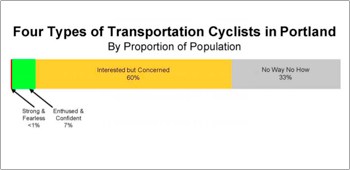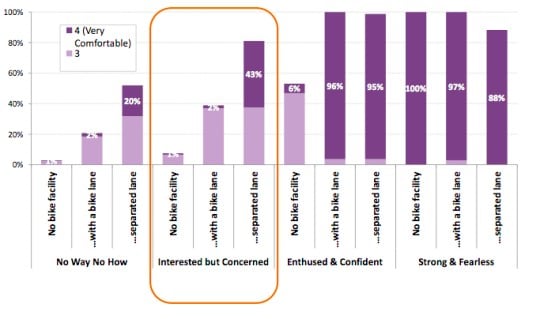
It’s been six-and-a-half years since Portland Bureau of Transportation bicycle coordinator Roger Geller first defined the “Four types of cyclists”. Geller’s insights proved to be groundbreaking and his definitions have stood the test of time. I frequently hear references about the need to attract more “Interested but concerned” riders at conferences all over the country and I read about them in articles in media large and small.
Now a noted bicycle researcher at Portland State University, Jennifer Dill, is working to learn more about the various types of riders. At the recent Velo-City conference in Vancouver B.C., she shared her research, Categorizing Cyclists: What Do We Know? Insights from Portland, OR (PDF). Now her work has been made public.
The objective of Dill’s research was to look at Geller’s “Four types” and either confirm them as a useful labeling tool, or devise a new way of understanding them. She also wants to understand the various types of riders better, so that planners and engineers can tailor solutions to their needs and ultimately increase bike usage.
Between July and August of 2011, Dill’s team used a phone survey to contact Portland residents and then asked them a series of questions about themselves, their riding habits (or if they rode at all) and about how they felt about riding in different types of conditions. Dill used answers to her questions about relative comfort level in different riding conditions (like an off-street path versus a busy street with no bike lanes) to put the 900 respondents into one of Geller’s four categories: No way no how, interested but concerned, enthused and confident, and strong and fearless.
For example, here’s how people responded when asked to agree or disagree with: “If or when I ride a bike, I’m concerned about being hit by a motor vehicle”:

Another interesting finding in Dill’s research is how gender plays out over the four types (51% of the respondents were women). Of the 51% of people surveyed who were women, only about 20% qualify as “strong and fearless” or “enthused and confident”. As the slide below illustrates, only 20% of the “strong and fearless utilitarian cyclists” are women.

And not surprisingly, the “strong and fearless” is overwhelmingly young (18-34):

In a nod to how this research can help influence the types of facilities cities should build, one of the questions asked respondents to share how they felt about riding on different facilities. Dill asked participants to imagine bicycling on the following type of facility: “A major urban or suburban street with four lanes, on-street parking, traffic speeds of 30- 35 miles per hour, and no bike lane.” Then she asked, “What if a striped bike lane was added?” and then, “What if it also had a wide bike lane separated from traffic by a raised curb or parked cars?”
As highlighted in the chart below, having facilities that are physically separated from traffic has a huge impact on the “interested but concerned”:

Dill says she’s got more analysis to do before her full report is complete. In the meantime, feel free to share your feedback and ideas via her PSU staff webpage.
Note: Dill’s research is funded by the Oregon Transportation Research and Education Consortium and the City of Portland.

